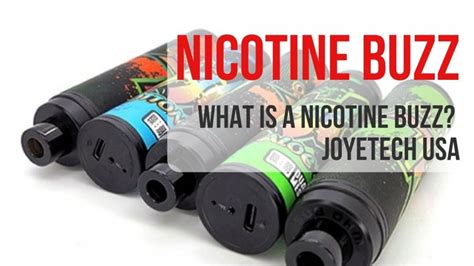Nicotine Buzz: Embracing a Future Free from Nicotine
The "nicotine buzz"—that fleeting feeling of stimulation and heightened alertness—has captivated millions, hooking them on tobacco products and nicotine-containing e-cigarettes for decades. But the future is shifting. A growing understanding of nicotine's addictive properties and its long-term health consequences is fueling a global movement towards a nicotine-free existence. This article delves into the allure of the nicotine buzz, explores the harmful effects of nicotine addiction, and outlines the pathways to a healthier, nicotine-free future.
What Causes the Nicotine Buzz?
The nicotine buzz is a complex interplay of physiological and psychological factors. Nicotine, a highly addictive stimulant, acts on the brain's reward system, triggering the release of dopamine. This dopamine surge creates feelings of pleasure, relaxation, and increased focus. However, this feeling is temporary. The brain quickly adapts to the nicotine, demanding more to achieve the same effect, leading to dependence and escalating consumption.
How Long Does a Nicotine Buzz Last?
The duration of a nicotine buzz varies greatly depending on the delivery method (cigarette, vape, patch, etc.), the amount of nicotine consumed, and individual factors like metabolism and tolerance. Generally, the initial buzz is felt within seconds to minutes, peaking within 10-20 minutes, and gradually fading over an hour or two. However, the craving for another nicotine hit often precedes the complete dissipation of the buzz, perpetuating the cycle of addiction.
The Dark Side of the Nicotine Buzz: Long-Term Health Risks
While the initial nicotine buzz may feel pleasurable, the long-term consequences are severe. Prolonged nicotine exposure is linked to a multitude of health problems, including:
- Cardiovascular disease: Nicotine increases heart rate and blood pressure, raising the risk of heart attacks, strokes, and peripheral artery disease.
- Respiratory illnesses: Smoking and vaping nicotine damage the lungs, increasing susceptibility to chronic obstructive pulmonary disease (COPD), emphysema, and lung cancer.
- Cancer: Nicotine is a potent carcinogen, increasing the risk of various cancers, including lung, throat, bladder, and kidney cancer.
- Diabetes: Nicotine can impair insulin function, increasing the risk of developing type 2 diabetes.
- Cognitive impairment: Nicotine can negatively impact memory, concentration, and overall cognitive function, especially in young adults whose brains are still developing.
Is There a Safe Level of Nicotine?
There's no safe level of nicotine consumption. While some argue that lower nicotine products are less harmful, any level of nicotine exposure carries health risks and contributes to addiction. The addictive nature of nicotine makes it incredibly difficult to control consumption, even with lower-dose products. A nicotine-free lifestyle is the ultimate goal for optimal health.
Breaking Free from the Nicotine Buzz: Effective Strategies
Quitting nicotine is challenging, but achievable with the right support and strategies. Several effective methods are available:
- Nicotine Replacement Therapy (NRT): This involves using patches, gum, lozenges, or inhalers to gradually reduce nicotine dependence.
- Medication: Certain prescription medications can help manage nicotine withdrawal symptoms and cravings.
- Counseling and therapy: Behavioral therapies, such as cognitive behavioral therapy (CBT), can help individuals identify and change nicotine-related behaviors and coping mechanisms.
- Support groups: Joining support groups provides a sense of community and shared experience, which can be incredibly helpful during the quitting process.
Embracing a Nicotine-Free Future: A Healthier Lifestyle
A nicotine-free future is not only achievable but also profoundly beneficial. By breaking free from the nicotine buzz and its associated health risks, individuals can significantly improve their overall health, well-being, and quality of life. This involves adopting healthy lifestyle choices such as regular exercise, a balanced diet, and stress management techniques. Remember, seeking professional help is a sign of strength, not weakness, and can significantly increase your chances of success in quitting nicotine.
Frequently Asked Questions (FAQ)
How long does it take to get rid of nicotine from your system?
The time it takes for nicotine to fully clear your system depends on factors like how much you used, how often, and your metabolism. Nicotine itself is eliminated relatively quickly, but its metabolites can remain detectable in urine for days or even weeks after cessation.
What are the early signs of nicotine withdrawal?
Early signs of nicotine withdrawal can include intense cravings, irritability, anxiety, difficulty concentrating, increased appetite, and sleep disturbances. These symptoms usually peak within the first few days after quitting and gradually subside over time.
What are some healthy alternatives to nicotine for relaxation?
Healthy alternatives to nicotine for relaxation include exercise, mindfulness meditation, deep breathing techniques, spending time in nature, engaging in hobbies, and connecting with supportive friends and family.
Can vaping help you quit smoking?
While some claim vaping aids in quitting smoking by reducing nicotine dependence gradually, scientific evidence remains inconclusive. Many individuals find themselves transitioning from cigarettes to vaping, maintaining nicotine addiction through a different delivery method. A nicotine-free approach is generally recommended for long-term health.

